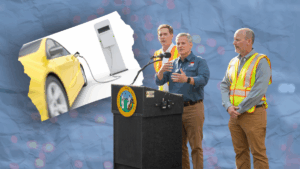Source: Editorial Board
A right-wing disinformation campaign targeting residents of western North Carolina affected by Hurricane Helene – many of whom are Republicans – is having a real impact on the ongoing response and recovery efforts happening on the ground.
Disinformation and conspiracy theories, ranging from Democrats controlling the weather and moving the storm into areas of Republican voters to FEMA not having a presence in the mountains and/or turning away volunteers, are being pushed by Republicans like Donald Trump, Lt. Gov. Mark Robinson and conservative social media influencers.
The lies have gotten so bad that FEMA contractors had to stop working over the weekend recently because of threats made against them by armed militias in Rutherford County. One man was arrested and charged for making threats.
Even some Republican lawmakers who represent western North Carolina have called for their supporters to stop spreading disinformation and have praised the response from the state and federal governments.
To counter some of the disinformation you may be hearing, we will provide a few facts about the government’s response to Helene.
State and federal government’s response to Helene:
- About 3,400 soldiers and airmen are on the ground in western North Carolina, including a task force led by the N.C. National Guard that features personnel from 12 different states, two different XVIII Airborne Corps units from Ft. Liberty, a unit from Ft. Campbell’s 101st Airborne Division, as well as various civilian organizations.
- National Guard and military personnel are operating 11 aviation assets and more than 1,200 vehicles suited for the mountainous terrain. The U.S. Army Corps of Engineers is helping to assess water plants, dams and wastewater facilities.
- FEMA has so far provided more than $129 million in Individual Assistance funds directly to people in Western North Carolina and more than 207,000 people have registered for Individual Assistance.
- More than 6,200 people have been able to get temporary housing through FEMA’s Transitional Sheltering Assistance.
- More than 1,200 FEMA staff are in North Carolina to help with the relief effort. They are helping with search and rescue efforts and providing commodities. They are also meeting with survivors in shelters and neighborhoods to provide quick access to relief.
- The Major Disaster Declaration requested by Gov. Roy Cooper and granted by President Joe Biden weeks ago now includes 27 counties and the Eastern Band of Cherokee Indians (25 counties were previously included).
- More than 1,500 responders from 38 state and local agencies have undertaken 135+ missions supporting the recovery and response efforts through the Emergency Management Assistance Compact. Some of these responders include nurses and emergency management teams that are supporting local governments, veterinarians, search dog teams and more.
- In addition to food, water and basic necessities being delivered on the ground, the state National Guard is also providing these items via airdrop for people in areas where helicopters can’t land. There are also distribution sites throughout western North Carolina where people can pick up supplies.
State and federal leaders respond to Helene:
State and federal government leaders and officials have also responded to the needs of those impacted by Helene. President Joe Biden took an aerial tour of the damage with Gov. Roy Cooper after the storm hit. Biden then announced a 100% FEMA reimbursement for the next six months, a significant investment that will support the continuing cleanup, recovery, and search-and-rescue efforts. The president also quickly approved Cooper’s request for active-duty military personnel and equipment to support operations in WNC and declared a major disaster in North Carolina, which allowed local governments and individuals to access FEMA assistance.
Several days after the president’s visit, Vice President Kamala Harris traveled to the state to meet with families impacted by Helene. She returned to the state last weekend for a rally in Greenville but stopped in Raleigh the day before to help pack bandages, baby formula, baby wipes, pain relief pills and other items for victims of Hurricane Helene.
On her first post-Helene visit to North Carolina, Harris promised federal assistance would continue to flow and announced that the Biden-Harris administration would provide $100 million to repair Interstate 40, portions of which washed away in some areas.
How the NC Legislature is responding to Helene:
Despite the lies and political games being played by some on the right, and except for Robinson, most North Carolina lawmakers have put their politics aside (for the time being) to come together and provide funding to help western North Carolina recover.
Legislators came back to Raleigh and worked with Cooper, the state Board of Elections and the state Department of Public Instruction to put together a $273 million Helene recovery package. The bill was passed unanimously on Oct. 9 and was signed by the governor the next morning.
“Recovery for Western North Carolina will require unprecedented help from state and federal sources and this legislation is a strong first step,” Cooper wrote when he signed the bill. “Hurricane Helene caused catastrophic damage but also showed the resiliency of North Carolina’s people and its communities, and we must continue the bipartisan work to help them build back strong.”
Cooper and legislative leaders described the $273 million measure as the first of multiple relief bills they intend to pass in the coming weeks and months. The state government has billions of dollars in a “rainy day fund” for emergencies or budget shortfalls, WRAL reported.
Helene’s impact on voting in western North Carolina:
State and local elections officials deserve a ton of credit for the work they’ve done to ensure all North Carolinians can do their civic duty. Early voting is now underway at 419 early voting sites across all 100 North Carolina counties, including 76 out of 80 planned sites in the 25 western North Carolina counties listed in the federal disaster declaration, North Carolina State Board of Elections Executive Director Karen Brinson Bell said last week.
Bell said that losing only four sites “despite the extensive damage, loss of power, water, internet and phone service and the washing out of roads throughout the region” is a testament to the response effort.
“An enormous amount of credit goes to our emergency management and FEMA partners, power companies, and, of course, the county boards of elections in the western part of the state,” she said. “To have almost all early voting sites open after such a devastating storm is an effort all North Carolinians should be proud of.”
Early voting began on Oct. 17 and ends Nov. 2 at 3 p.m. Election Day is Nov. 5.
If you live in an area affected by Hurricane Helene, the NCSBE has created a page with all the information voters there need to know.
Need help or want to help?
If you would like to donate to the North Carolina Disaster Relief Fund, visit nc.gov/donate. Donations will help to support local nonprofits working on the ground.
For information on volunteer opportunities, visit nc.gov/volunteernc.
North Carolinians can apply for Individual Assistance by calling 1-800-621-3362 from 7 a.m. to 11 p.m. daily, or by visiting www.disasterassistance.gov, or by downloading the FEMA app. FEMA may be able to help with serious needs, displacement, temporary lodging, basic home repair costs, personal property loss or other disaster-caused needs.





